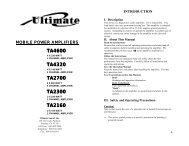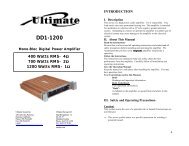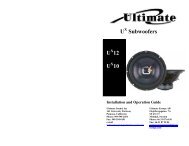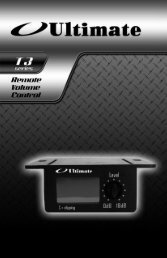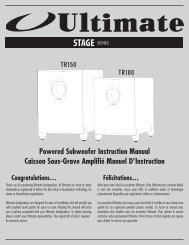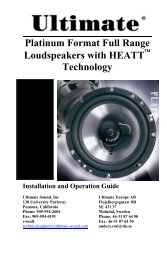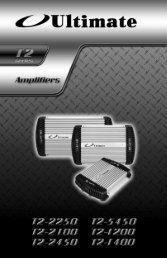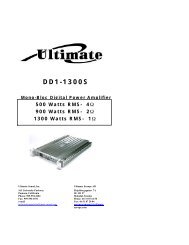UHC Series - Ultimate Sound
UHC Series - Ultimate Sound
UHC Series - Ultimate Sound
- No tags were found...
You also want an ePaper? Increase the reach of your titles
YUMPU automatically turns print PDFs into web optimized ePapers that Google loves.
HIGH CURRENT POWERAMPLIFIERS<strong>UHC</strong>51 X 150 + 4 X 60W RMS5 CHANNEL AMPLIFIER<strong>UHC</strong>44 X 60W RMS4 CHANNEL AMPLIFIER<strong>UHC</strong>22 X 60W RMS2 CHANNEL AMPLIFIERULTIMATE ®138 University ParkwayPomona, CA 91768Toll Free: 888-909-9988Telephone: 909-594-2604Fax: 909-594-0191
INTRODUCTIONI. DescriptionThis device is a high power, audio amplifier. Use it responsibly. Veryloud music can cause permanent hearing loss. This amplifier is intendedfor installation in vehicles with a 12-Volt, negative ground electricalsystem. Attempting to connect or operate the amplifier in another type ofelectrical system may cause damage to the amplifier or the electricalsystem.II. About This ManualRead the Instructions-Be sure that you have read all operating instructions and understand allsafety precautions before installing and operating the amplifier. Werecommend that you have your <strong>UHC</strong> amplifier installed by a specialist.Follow the Instructions-The instructions are intended to help you safely obtain the bestperformance from the amplifier. Carefully follow all installation andoperating instructions.Save the Operating Manual-Keep the manual in a safe place after installing the amplifier. You mayhave questions later.Text Conventions used in this Manual-Bold-Headings and important information.Bold, Underlined-Very important information."Bold"-As labeled on the amplifier, or quoted from elsewhere in thismanual.III. Safety and Operating Precautions-Caution!This symbol warns the user of a potential risk or hazard if instructionsare not followed.⇒ This arrow symbol points to a specific instruction for avoiding apotential hazard.ii
Step 5- Use the supplied Allen head screws to mount the end caps to theends of the main heat sink.Step 6- Use the supplied screws to attach the end caps to the mountingsurface.Caution!⇒ Make sure to mount the amplifier using the supplied screws andrubber bushings. Do not mount the amplifier by the end caps alone.1.2 Installation- Power ConnectionsStep 1- Run a power cable from the battery to the amplifier mountinglocation. Use rubber grommets to protect the cable anywhere it has to gothrough metal.<strong>UHC</strong>5, <strong>UHC</strong>4 - Use #4 AWG or larger power and ground cable.<strong>UHC</strong>2 - Use #8 AWG or larger power and ground cable.Step 2- Connect one end of an in-line fuse holder to the power cable.Connect the other end of the fuse holder to the positive battery post with20 cm (or less) of the same cable. This fuse location will protect thesystem and the vehicle against the possibility of a short circuit in thepower cable. Be sure to use a fuse and fuse holder adequate for theapplication. Do not place a fuse in the holder at this time. The fuserating is depending on the power- and ground cable size. The maximumfuse rating for each amplifier in the <strong>UHC</strong> series is:<strong>UHC</strong>5 - 80 Amp <strong>UHC</strong>4 - 80 Amp<strong>UHC</strong>2 - 40 AmpCaution!⇒ Bridging fuses or replacing a fuse with one of a higher rating maycause damage to the amplifier and the vehicle's electrical system.Step 3- Run a remote turn on cable from the switched +12V source youwill be using to turn on the system components. This may be a toggleswitch, a relay, or your source unit’s remote trigger wire, or powerantenna trigger wire. Run this lead to the amplifier mounting location.Use #18 AWG wire or larger.Step 4- Locate a secure grounding connection as close to the amplifier aspossible. Make sure the location is clean and provides a direct electricalconnection to the frame of the vehicle. Connect one end of a short pieceof the same size cable as the power cable to the grounding point. Run theother end of the cable to the amplifier mounting location.Step 5- connect the ground cable to the screw terminal labeled“POWER, (GND)”.Step 6- Connect the power cable to the amplifier at the screw terminallabeled “POWER, +12V”.2
Step 7- Connect the remote turn on cable to the screw terminal labeled“POWER, (REM)”.1.3 Installation- Speaker ConnectionsStep 1- Run #16 AWG or larger connecting wire from your speakers tothe amplifier mounting location. Keep speaker wires away from powercables and amplifier input cables. Use grommets anywhere the wires haveto pass through holes in the metal frame or sheet metal. Connect to thespeakers according to the type of terminals on each speaker.Step 2- Strip 3/8" of insulation from the end of each wire and twist thewire strands together tightly. Make sure there are no stray strands thatmight touch other wires or terminals and cause a short circuit.Step 3- Crimp spade lugs over the wire ends or tin the ends with solder toprovide a secure termination.Step 4- Connect the wire ends to your amplifier as follows:<strong>UHC</strong>5, <strong>UHC</strong>4- "FRONT" and "REAR" SPEAKERTERMINALSFRONTSPEAKER(L+) (L-) (R+) (R-)<strong>UHC</strong>4REARSPEAKER(L+) (L-) (R+) (R-)( + ) ( - )BRIDGEFollow the left, (L+) (L-),and right, (R+) (R-),channel and polaritymarkings, making sure theymatch the channel andpolarity of the connectionsat the speakers.<strong>UHC</strong>5FRONTREAR( + ) ( - )BRIDGESPEAKER(L+) (L-) (R+) (R-)BRIDGE( + ) ( - )3
<strong>UHC</strong>5- SUBWOOFER TERMINALSSUBWOOFER(+) (-)<strong>UHC</strong>2- SPEAKER TERMINALSFollow the left, (L+) (L-), and right, (R+) (R-), channel and polarity markings, making surethey match the channel and polarity of theconnections at the speakers.MULTIPLE SPEAKERCONNECTIONFollow the polarity(+) (-) markings first. Youmay want to experiment with reversing the (+)and (-) connections to see which way soundsbest. The subwoofer channel is 1Ω stable, andcan drive up to four 4Ω subwoofers connectedin parallel.SPEAKER(L+) (L-) (R+) (R-)( + ) ( - )BRIDGEPARALLEL- Each additional speaker decreases the load impedancefor the amplifier. The amplifier delivers more current and worksharder.PARALLEL CONNECTION USING 4 OHM SPEAKERS4 Ohm 2 Ohm 1.3 Ohm 1 OhmAMOPULTIPFUITER+-(+)(-)(+)(-)(+)(-)(+)(-)SERIES- Each additional speaker increases the load impedance forthe amplifier. Impedances higher than 8 ohms are rarely used for caraudio.4
SERIES CONNECTION USING 4 OHM SPEAKERS4 Ohm 8 Ohm 12 Ohm 16 OhmAMOPULTIPFUITER+-(+)(-)(+)(-)(+)(-)(+)(-)1.4 Installation- Self-Bridging, 2+1 ModeSPEAKER(L+) (L-) (R+) (R-)BRIDGED MONO- <strong>UHC</strong>4, <strong>UHC</strong>2Connect a 4Ω or 2Ω ohm speaker ormultiple speaker load to the terminalsmarked “(+), BRIDGE, (-)”, making ( + ) ( - )sure they match the polarity of theBRIDGEconnections at the speakers.Caution!⇒ Speaker or multiple speaker loads totaling less than 4 ohms are notrecommended for “Bridged” or “2+1 Mode” to the 4 channel outputterminals of the <strong>UHC</strong>5, and may damage the amplifier.2+1 MODE- (TRI-MODE)Simultaneous stereo and mono operation, “2+1 Mode”, requires a passivecrossover to send low frequencies to the mono speaker and higherfrequencies to the stereo speakers. The following table lists thecomponent values for a 6 dB/Octave crossover at common frequenciesusing 4 ohm speakers:FREQUENCY INDUCTOR CAPACITOR80 Hz 7.5 mH 470 uF100 Hz 6.5 mH 330 uF120 Hz 5.5 mH 330 uF150 Hz 4 mH 220 uF2+1 MODE WIRING DIAGRAM-Use 100 Volt, non-polar capacitors, and connect them in series with thestereo speakers as shown in the diagram. Connect the inductor in series5
with the mono speaker as shown in the diagram. Be sure the inductor israted to handle the power of your amplifier.(+)L(+)L (-)R(+)R (-)IN DUCTOR(+)(-)(-)CAPACITORS(+)(-)1.5 Installation- Input ConnectionsLow Level, High Impedance, Gold Plated RCAInput Jacks-For connecting to a source providing preamp leveloutputs. Use heavy duty RCA patch cords designed formobile applications . Run the patch cables carefully,maintaining as much distance as possible from power,speaker, and accessory wiring. Make sure the RCAplugs fit tightly for a secure connection.INPUT<strong>UHC</strong>4<strong>UHC</strong>5INPUTRLINPUTFRONT REARRLRLRLRLLINEINPUTLINEOUTPUT<strong>UHC</strong>2- High Impedance, Gold Plated RCAInput and Output Jacks- The <strong>UHC</strong>2 features apair of preamplifier output jacks to provide aninput signal to another amplifier or component inthe system. The output signal is preamplified tomaintain signal quality.<strong>UHC</strong>5- SUBWOOFER CHANNELThe <strong>UHC</strong>5 subwoofer channel is connected internally to the RCA inputjacks. There are no separate inputs for the subwoofer channels.6
1.6 Installation- Check all ConnectionsRecheck all connections before reconnecting the negative(-) battery cable.Insert the correct value fuse in the fuse holder at the battery beforeattempting to turn on the system.2. Operation2.1 Operation- Input Level adjustmentsLEVELVOLTS5.0-0.15Adjust the input level for the marked channel(s) with a smallscrewdriver through the opening marked “LEVEL”. TurnCW(clockwise) to increase the level, CCW(counterclockwise)to decrease. Amplifiers will run cooler and produce lesssystem noise at lower level settings.Consult an experienced installation specialist for assistance in balancingthe levels in multi-amplifier systems, or systems with signal processingaccessories.<strong>UHC</strong>5- SUBWOOFER CHANNELSThe subwoofer channels have frequency adjustment and level controls butno separate RCA input jacks. Use a small screwdriver to adjust the lowpass level through the opening marked “SUBWOOFER, LEVEL".2.2 Operation- Optional Remote SubwooferLevel ControlREMOTE SUBWOOFERVOLUMEMINMAXMount the optional accessory remote level controlin an accessible location and run the connectingcable back to the <strong>UHC</strong>5. Connect the subwooferremote level control by plugging the telephoneplug at the end of the accessorycable into the RJ-11 telephonejack on the <strong>UHC</strong>5. Set the "Low-Pass" output level to themaximum level possible (full CW). Adjust the remotelevel control CW to increase the subwoofer level, CCWto decrease the subwoofer level.REMOTEBASSRJ117
2.3 Operation- Electronic NoiseReduction(ENR)ENRLENRRIt is usually not necessary to change the factoryENR setting. The ENR adjustment capabilityallows you to fine tune the balanced inputcircuits through the openings marked "ENR, L,R" for maximum noise rejection.To properly adjust the ENR requires:A small, non-metallic, alignment tool that will fit through theopening. One is supplied with your <strong>UHC</strong> amplifier.A small speaker that you can hold up to your ear while itis connected to the amplifier.The amplifier must be installed correctly, and connected tothe source and any other components normally used in thesystem.Caution!⇒ Never insert anything metallic into any openings in the amplifier sidepanels.1. With the system turned off, disconnect the main speakers from thechannels you are going to fine tune.2. Mark the position(s) of the "LEVEL" control(s) for the channel(s) youare going to fine tune.3. Turn the "LEVEL" control(s) fully CW for the channel(s) you aregoing to fine tune.4. Connect the small speaker to the channel you want to adjust.5. Make sure the source unit volume is fully CCW (volume completelyturned down).6. Start the engine, and turn on the system.7. Use the small screwdriver to adjust the ENR for the channel thespeaker is connected to. Listen to the speaker, and adjust for theminimum noise level.8. Repeat for any other channel you wish to fine tune.8
2.4 Operation- Built-in Crossovers<strong>UHC</strong>5, <strong>UHC</strong>4, <strong>UHC</strong>2- CROSSOVER SELECTIONThe <strong>UHC</strong> amplifiers have built-in low-pass and highpasscrossovers for bi-amplifying your system. SelectCROSSOVER"FULL, LPF, or HPF" by moving the position ofFULL-LPF-HPF the slide switch for each pair of channels. Selecting"FULL" defeats the crossover functions<strong>UHC</strong>5, <strong>UHC</strong>4, <strong>UHC</strong>2- FREQUENCY ADJUSTMENTFREQ. After selecting the crossover function, adjust the low pass orhigh pass frequency with a small screwdriver through theopening marked “FREQ.”. Turn CW to set to a higherfrequency, CCW to set to a lower frequency.HERTZ50-250<strong>UHC</strong>5- SUBWOOFER CHANNELUse a small screwdriver to adjust the low pass frequency through theopening marked “SUBWOOFER, FREQ.”2.5 Operation- Protection Circuits andL.E.D. IndicatorsPWR.“PWR.” L.E.D. INDICATOR- Provides a visual indication thatthe amplifier is turned on.“PROT.” L.E.D. INDICATOR- Provides a visual indicationPROT. that a problem exists and the protection circuitry has protected theamplifier by shutting it down. Turn the system off and correct theproblem before turning the system back on.THERMAL PROTECTION- The amplifier will shut down if itstemperature exceeds a safe operating level. The amplifier will remain offuntil it cools to a safe operating temperature. Exercise care, the exteriorof the amplifier may get uncomfortably hot to the touch before shuttingdown.OVERLOAD AND SHORT CIRCUIT PROTECTION- The amplifierwill shut down if a short circuit condition exists, or if electrical currentdemands exceed safe levels.D.C. OFFSET PROTECTION- The amplifier will shut down if anunsafe D.C. offset condition exists.FUSE 30A30AFUSE PROTECTION- A blown fuse indicates aproblem that should be corrected before the fuse isreplaced. Always replace with the same value fuse.Never substitute a larger value fuse.9
2.6 Operation- Location of Terminals,Controls and LED indicators<strong>UHC</strong>51. RCA input jacks 2. Input level adjust 3. Crossover select4. Frequency adjust 5. ENR adjust3 4 5 2 5 1 5 2 5 4 32 4CROSSOVER FREQFRONTENRL LEVELENRRFRONTREARENRLLEVELREARENRRFREQCROSSOVERREMOTECONTROLSUBWOOFERLEVELFREQRR50Hz 250Hz 5 V 0.15V5 V0.15V50Hz250Hz5 V0.15V 50Hz250HzFULLLOW-PASSHI-PASSLLFULLLOW-PASSHI-PASS1. Power terminals 2. Power L.E.D. 3. Protection L.E.D.4. Speaker terminals 5. Subwoofer terminals 6. Fuses4 31 6 2 5(L+)SPEAKER(L-) (R+)(R-)PROT+12VPOWERREMGNDPWRSUB WOOFER(+) (-)FRONTREAR(+) BRIDGE (-)FUSE-40A40AFUSE-40A40A<strong>UHC</strong>41. RCA input jacks 2. Input level adjust 3. Crossover select4. Frequency adjust 5. ENR adjust3 4 5 2 5 15 2 5 4 3CROSSOVERFREQENRLFRONTLEVELENRRINPUTINPUTENRLREARLEVELENRRFREQCROSSOVER50Hz250Hz5 V0.15VLRLR5 V0.15V50Hz250HzFULLHI-PASSFULLHI-PASSLOW-PASSLOW-PASS1. Power terminals 2. Protection L.E.D. 3. Power on L.E.D.4. Speaker terminals 5. Fuses4 3 2154(L+)REARSPEAKER(L-) (R+)(R-)PWRPROT +12VPOWERREMGND(L+)FRONTSPEAKER(L-) (R+)(R-)(+)BRIDGE(-)FUSE-40A40AFUSE-40A40A(+)BRIDGE(-)10
<strong>UHC</strong>21. RCA input jacks 2. Input level adjust 3. Crossover select4. Frequency adjust 5. ENR adjust 6. RCA output jacks3 4 25 5 6 1FREQLEVELENRLINEOUTPUTLINEINPUTLRRR50Hz250Hz5V0.15VFULLHI-PASSLOW-PASSLLCROSS OVER1. Power terminals 2. Protection L.E.D. 3. Power on L.E.D4. Speaker terminals 5. Fuse51 3 24FUSE40APOWER+12V REM GNDPWR PROT(L+)SPEAKER(L-) (R+)(R-)40A(+)BRIDGE(-)11
Appendix A: Features and SpecificationsStandard Features-<strong>UHC</strong>55 CHANNELPOWERAMPLIFIER<strong>UHC</strong>44 CHANNELPOWERAMPLIFIER<strong>UHC</strong>22 CHANNELPOWERAMPLIFIERCircuit Double sided, glass epoxy, through hole mountedBoard2Ω StableYes1Ω Stable SubwooferYesYesChannelBridgeable Channel 1-4 8Ω, 4Ω, or 2Ω 8Ω, 4Ω, or 2Ω8Ω, or 4ΩTri-modeYes, self-bridgingTerminals Gold plated RCA jacks, speaker and power terminalsSoft StartYesInputCircuitryBICFloating ground, balanced input circuitry for maximumElectronicNoiseReduction Line Output(full range)Built-inCrossoverProtectionMOSFET,PWMPowerSupplySupplyVoltagenoise rejectionYes, adjustable for maximum effectiveness- - -RCA line outYes, Low Pass, High Pass, 12dB/Octave, 50-250Hz.Protected against thermal and electrical overload, shortcircuitand DC offsetRegulated, Pulse Width Modulated, MOSFET powersupply+12VDC, Negative ground12
Performance Specifications-RMS Power,4Ω, THD20010Hz. – 50kHz. 10Hz. - 50kHz. 10Hz. - 50kHz.-65dBA -65dBA -65dBA150mV – 5.0V 150mV - 5.0V 150mV - 5.0V25kΩ 25kΩ 25kΩFuse 2 X 40A 2 X 40A 40AThese specifications are subject to change in the continuing effort toimprove the product.13
Appendix B: TroubleshootingCondition Possible Cause Possible SolutionNo soundAmplifiershut downDistortionPoor bassresponseTickingnoiseWhiningnoiseLow or no remote turnon voltage, or no remoteturn on connectionBlown fuse(s)Wiring problemsBlown speakersProtection circuitprotecting againstoverheating or overloadInput level not properlyadjustedSpeaker damageSpeakers out of phaseRadiated noise fromspark plug wiresAlternator noise causedby poor grounding ofamplifier, source, othercomponent, battery, oralternatorCheck the remote turn onconnection and the voltage atthe amplifier and source unitCheck all system fusesRecheck all connectionsCheck for short circuitsCheck speakers on anotheramplifierCheck for adequate ventilationCheck load impedance(2 ohmstereo, 4 ohm bridged)Check speaker wiring for shortto the vehicle chassisReduce input levelReadjust amplifier input levelCheck speakers on anotheramplifierRecheck speaker wiringReverse polarity of one channelReroute amplifier input wiringInstall a noise filterAdjust ENR Check all ground connectionsInstall a noise filter on thesource unit’s power cableInstall a coupling transformerin the signal path to improveground isolation for the signalpathAdjust ENR 14



